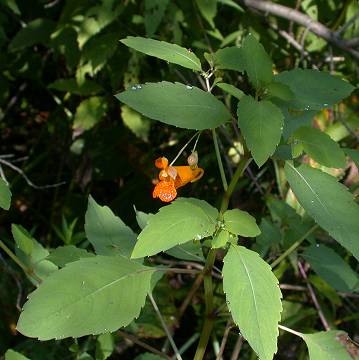

Impatiens capensis - (image 1 of 5)
Taxonomy
Family: Balsaminaceae
Habitat
Moist woods, calcareous fens, marshes, lake shores.
Associates
Distribution
Throughout eastern U.S. and Canada, and parts of the northwest.
Morphology
Annual to 5'. Leaves mostly alternate, sometimes opposite, simple, ovate, cuneate, on distinct petioles, the teeth broadly rounded and mucronate, those of flowering branches rarely more than 8cm long. Stems glabrous, translucent, succulent. Flowers orange, often spotted with red-orange, the fully developed spur more than 6mm long. Fruit a capsule that explodes when mature, scattering the seeds.
Notes
Flowers mid July to late September
Wetland indicator: Facultative Wetland
The flowers of this plant attract bumblebees and hummingbirds. Can be found growing in both shade and sun, although it does not seem to prefer shade as much as I. pallida. Also called jewelweed for the silvery appearance of the leaves when covered in water. The water sap of this plant can be used to sooth the itchy rash caused by poison ivy.
References
Dirr, Michael A. 1998. Manual of Woody Landscape Plants:
Their Identification, Ornamental Characteristics, Culture, Propagation and Uses.
5th ed. Champaign, Illiois: Stipes Publishing L.L.C.
Swink, F. and G. Wilhelm. 1994. Plants of the Chicago Region.
Indiana Academy of Science. The Morton Arboretum. Lisle, Illinois.
|
Michael Hough © 2005 |